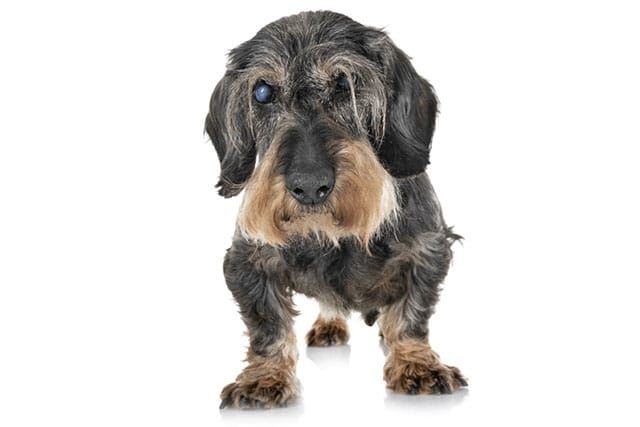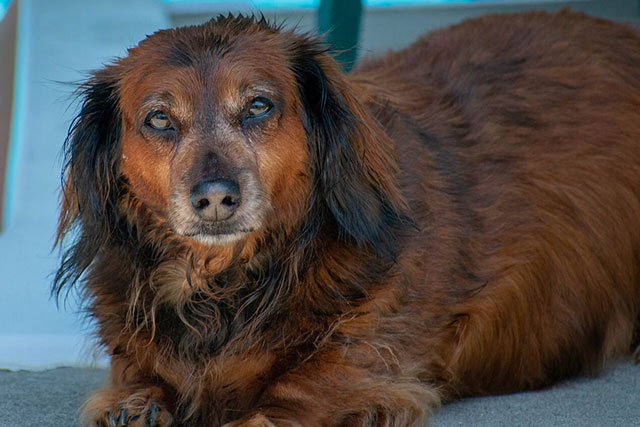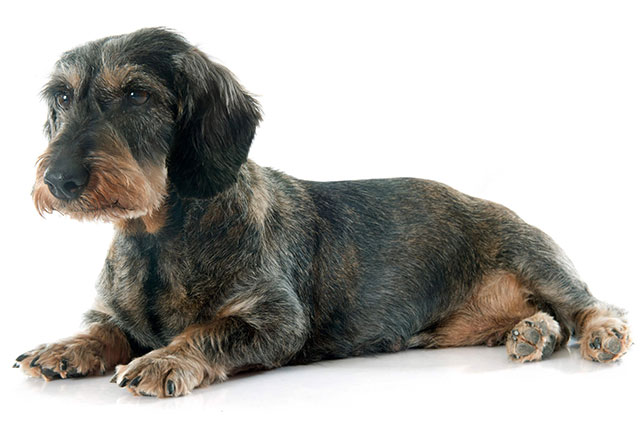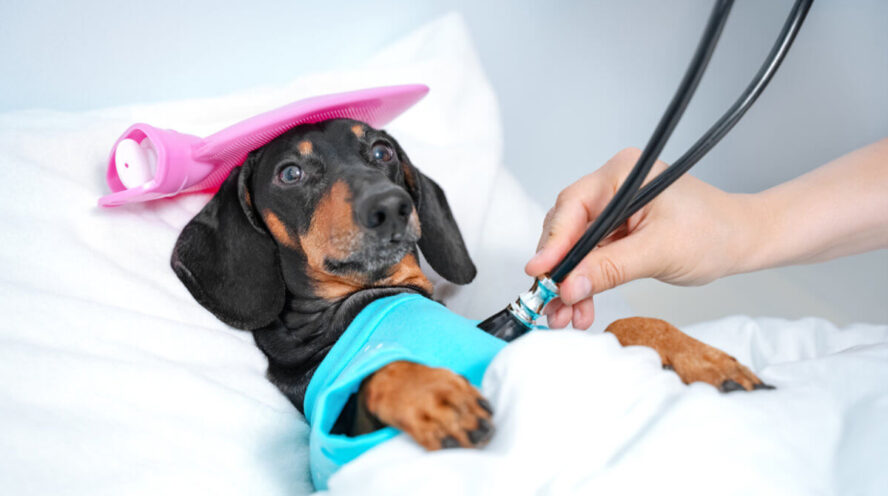Dachshunds are one of the most amazing dogs to own, to love, to care for and to allow into one’s space.
The high and energetic personality, their amazing friendliness, their great nose that detects foul smells when your human nose fails…
Their long and slender model-type walking posture and so on, I mean, I could go on about all the things we love about our little wieners!
Yet, sadly, genetically dachshunds are predisposed to quite a few health conditions. In this article we are going to talk about dachshunds health problems and how to prevent them.
What Health Problems Are Dachshunds Prone To?
As we know, life is about ups and downs, highs and lows.
Every human being can attest to this; our genes, body types, environments, lifestyle choices, food preferences, diet habits, exercise behaviour all form a combination of factors that affect our health, lifespan, general wellbeing, and most especially physical health.
By the same token, it applies to Dachshunds.
No matter the kind of Weiner; miniature, short-haired and long-haired ones, they develop some health issues more often than other breeds because of their morphology.
In a word, dachshunds health problems are back issues (intervertebral disk disease), hypothyroidism, canine cancer, eye cataract, some neurological disorders, skin problems, obesity, seizures or heart problems according to most recent researches.

Disclaimer here: This isn’t a “what-could-kill-your-dog” list.
It’s a “watch-out-for-these”, “prevention-is-better-easier-faster-cheaper” and “pay-attention-to-these” list.
We aren’t out to scare you and make you give out your cutie to the animal control centre because it will become a nuisance to you.
We are trying to help you take care of your dog, and this will result in increased life span, a life well-lived and one enjoyed. Don’t you want that for your dachshund?
Let’s pick each challenge one at a time.
Dachshunds health problems: Intervertebral Disc Disease (IVDD)
Intervertebral disk disease is a common condition in any “dwarf” breed of dog. However, dachshunds are much more susceptible to the disease.
Namely, IVDD is a condition in the spine which results in back pain, partial loss of function in the forelimbs and hind limbs. Not to mention, in the most severe cases, paralysis and limb loss can occur.
Firstly, let’s talk a little science. Let’s look at the spine of a dog. Their spine is made up of 7 cervical (that’s not the cervix, it’s the neck) vertebrae (this is a big science word for backbone), 13 thoracics (chest) vertebrae, 3 sacral vertebrae and 7 lumbar vertebrae which are all enjoined.
Also, there is a disc in between each vertebra, this disk is called an intervertebral disc and it’s a sole function is to provide a cushion between each entwined backbone.
Types of IVDD in dachshunds
There are two major types of IVDD:
✔️ Type 1 also known as Herniated or Slipped Disc:
Type 1 occurs when the inner layer of the disc suddenly faces a rupture through the top of the outer layer and this leads to a sudden compression of the spinal cord.
✔️ Type 2 also known as Bulging Disc:
Conversely, this ailment eliminates the suddenness that happens to the wear and tear in the spine. This is a slow and gradual bulging that pushes pressure on the spinal cord.
In rare cases, there is also Type 3 of IVDD, that causes a non-compressive contusion injury to the spinal cord. There is no resulting compression as the material dissolves.
The one that affects Dachshunds is Type 1.
Signs and symptoms of IVDD in dachshunds
- Pain and weakness in the hind legs
- Unwillingness to jump
- Anxiety
- Neck pain and stiffness
- Abdominal change (tenderness or tenseness)
- Hypersensitivity to touch and mobility
- Yelping during pat-time or lap-time
- Limping to walk
- Muscle spasms on the back or on the neck
- Reduced activity
- Lowered head stance
- Tremblings or shakings
- Paralysis in one or more limbs
- Collapse
- Lack of coordination.
These signs can appear at a sudden, can be progressive or take the slow and steady route. You have to pay attention enough to your dog most especially after he has engaged in strenuous and stretchy physical activity or just got recently injured.
Some of these signs can just appear out of the blue, so you are the one we depend on to pick up this change in movement and personality.
If you suspect any backbone or spine issues with your dog, take a trip to your veterinarian as soon as possible. They will conduct a thorough physical examination if they need to or a complete neurologic exam if need be.
Your vet will also be able to locate the exact section of the spine where the problem is originating from.
IVDD prevention methods
There is a role you can play in. For instance, you can help to noticeably reduce the potential for spinal stress by:
✔️ Avoiding high or continuous stressful jumps from one point or the other. Stop your dog from regularly going upstairs and downstairs.
✔️ Maintain your dog at a healthy weight with good and healthy food choices.
✔️ Provide support for your dog when holding them to keep their backs from arching; to keep them on a horizontal plane.
✔️Instead of using leashes, use a harness especially if your dog is a super active dog.
These may seem like obvious yet minimal practices, but they can go a long way to ensuring a long and happy life for your dog.
In case you want to find out more about Intervertebral Disk Disease, we wrote a detailed article on this subject, – “IVDD in dogs: how is your dachshund affected”.
Dachshund Health Problems: Eye Diseases
It’s important to mention that the genetics of the dachshunds make them prone to some serious eye defects.
Those cute little bright eyes can melt your heart but need to be paid the most attention as the eyes are part of the most essential parts of the body for optimal functioning.
These breeds of dogs are more prone to serious eye threats than his other canine counterparts. Namely, there are different kinds of dachshunds health problems of the eyes, including:
Dry Eye Syndrome
The eye is a sensitive organ that is filled with different nerves and one of such is the tear production gland. This ailment is characterised by reduced tear production. The condition can eventually lead to blindness.
Moreover, dachshunds are the most likely breed to be diagnosed with a related condition called PIGMENTARY KERATITIS .
It is is simply an irregularity in the cornea (which is a very important part of the eye) which is caused by too much air in the absence of proper amount of moisture.
How do you know that your dog has this? What are the signs look out for:
A mucus-like eye discharge and constant pawing at his eye. Just like every other issue, check in with a vet ASAP.
Cataracts

A cataract is usually a thin and cloudy lining formed on the lens of an eye due to an imbalance in the amount of water and calcium in the eye.
If your Weiner has a cataract, his eye will appear milky and initially, there will be a distortion of the light as it hits the lens.
As the disease becomes progressive, most dogs eventually go blind. Science says that most cataracts are inherited but the second most common cause is diabetes.
Surgical removal of cataracts can be performed by a vet, but it is a spendy procedure and most generally not reimbursed by pet health insurance policies.
According to Animal Eye Care, the genetic component of canine cataracts excludes them from coverage.
Glaucoma
This is a buildup of the natural fluid within the eye and is characterised by red and cloudy bulging eyes. It doesn’t threaten the life of your dog but only reduces the quality of his life.
The major cause of this is when there is an exchange of fluid (which is aqueous in nature) between the eye chambers and this exchange being out of balance.
A specialised ophthalmic examination is what a doxie requires before he can be diagnosed with this disease.
Gradual Loss of Vision
This is a major threat to your dog’s life. Referred to by veterinarians as gradual retinal decay, this eye issue is known as a decrease in the canine’s capacity to process light as a vital part in any form of compelling vision.
It is typically confused as night blindness when it begins.
As per the Dachshund Owner Guide, it is a condition in which the cells of the retina gradually die.
It is a retrogression, a peculiarity of the best possible working level for your buddy dog’s eyes.
It is first observed around evening time when less light for visual acuity is accessible.
Due to the genetic make-up of miniature long-haired dachshund, they have a higher genetic disposition to befall with this particular disorder than when compared to other species of wiener dogs.
As more and more retinal cells die off, it becomes starts to become impossible for the dog to see well anytime or even at all.
It becomes more pronounced even during day time hours as well. The light processing ability of the dog’s retina has been completely compromised as the cells have died off.
According to the American Kennel Club Canine Health Foundation is that there is no cure for this disorder, instead, gradual loss of vision in dogs can be managed.
Due to the disease being a gradual one, when detected early it is possible to help the dog adjust and adapt to its loss of sight.
The dachshund is a small dog with short legs and as such keeping furniture and fittings low is usually a good practice.
Gradual loss of the eyesight is a very frustrating common challenge dachshunds face and this is one of the hallmarks that make a sad pet owner.
The best way to help your dachshund live longer?
Watch our video to find out!
Dachshunds Health Problems: Hypothyroidism
In a word, Hormones are biological substances produced by living organisms. They ensure that those organisms can carry out their day to day activities, proper functioning, growth, development, and maintenance.
There are different tons of hormones and the thyroid hormone is one of the most significant.
The thyroid gland is in the neck and it secretes a hormone called thyroxin whose function is to control metabolism – the process of breaking down food into expendable energy units.
The hypothyroidism means that the hormone secreted by this gland isn’t just enough.
Symptoms of hypothyroidism in dachshunds
- Hair loss
- Dull coat
- Thin and flaky skin
- Black Patches
- Weight gain
- Decreased appetite
- Lethargy
- Sluggishness
- Slowed heart rate
- Cold intolerance
Note that this challenge is also tied to seizures, heart and blood vessel problems and eventually, infertility.
These secondary signs are the life-threatening issues that require a visit to the vet ASAP. It can also lead to outright obesity, which will create a strain in the spine and backbone.
Besides, female doxies with hypothyroidism often fall in and out of their cycles and experience real-time difficulties getting pregnant.
And when they do, they experience miscarriages. In dachshunds, there is a common phenomenon; pseudopregnancy which is a false pregnancy is an abdominal extension which makes it seem like your dog is pregnant.
This reduced production of thyroid essentially slows down its entire system and make it vulnerable to other illnesses and health challenges.
In dachshunds, the commonest type of hypothyroidism is lymphatic hypothyroidism. The dogs are usually affected between the ages of 1 and 3.
Namely, a number of factors can cause insufficient hormone production: age, environment, lifestyle, and exposure.
It could be an immune disease, lack of exercise, tumour on the thyroid, usage of bad drugs such as steroids and just adrenaline disorder.
Dachshund Health Problems: Obesity

Obesity in dogs isn’t a rare sight. It is an excess of white adipose tissue and it is as a result of energy expenditure less than energy reservation.
Obesity is linked to decreased life span, mobility, some cardiovascular challenges, hypothyroidism, increased risk of cancer and hyperthermia.
Causes of obesity
✔️ Overfeeding – feeding more than the Recommended Daily Allowance (RDA). The dietary factors that simulate this are human food, high fatty foods, and frequent meal intake.
✔️ Lack of exercise – a doxie that just eats and live a sedentary life is at high risk of being obese. No walking, strolling or mini exercises in the house kinds of dogs are beckoning on obesity with all they have.
✔️ Genetic predisposition too. Their morphological and genetic makeup of this breeds make them prone to obesity, this is why extra precaution should be taken to avoid getting here in the first place.
Obesity cannot be permanently taken out of the picture; it causes long-lasting changes in your dog even with a change in diet and exercise.
All that extra baggage of weight can cause lasting damage to your doxie’s internal organs, bones, and joints. The sooner you can reverse bad habits, the less likely it will dance to the tune of permanent eventualities.
Sometimes ago while I was doing my research on obesity, I found out that all the fat stored in obese living organisms releases inflammatory substances and this will further create oxidative stress on the tissue.
Body fat is much more than cushioning and a warm feeling when you hug or play them, obesity is a chronic condition that needs to be sorted out immediately.
Dachshund health problems: Seizures
Seizures are sort of a lightning bolt hitting one’s brain. There are tons of symptoms to identify when your hound is having a seizure, they are listed below.
Symptoms of seizures in dachshunds
- Loss of consciousness
- Convulsions
- Collapsing
- Jerking
- Muscle Stiffening
- Drooling
- Tongue chewing
- Chomping
- Foaming at the mouth
- Incontinence
- Eyes rolling uncontrollably
Seizures are usually dramatic and they might not be as frightening as they look.
Causes of seizures in dachshunds
There are different factors that cause a seizure in dachshunds:
- Food poisoning
- Low or high blood sugar
- Kidney disease
- Electrolyte misappropriation
What to do if your dachshund is having a seizure
If your dachshund has a seizure, you can be helpful. You can help stabilise him before you get to the doctor’s or before a medical specialist arrives.
The first thing you need to do though is call your vet if the seizure lasts more than 5 minutes – if the jerking and the dramatic convulsing is going on like a crazy circus show for more than 5 minutes.
Don’t move your dog when in seizure because to move or life he will require supporting his every weight. Remove other pets from the area, and reduce other stress-causing factors—turn off music or TV to eliminate noise, and turn off any bright lights.
Place soft cushions or blankets along the dog’s back and around his head, and provide a safe and quiet place for him to sleep and recover after the seizure has stopped.
Dachshunds Health Problems: Lafora Disease
This condition is one of the common dachshunds health problems, especially for a miniature wire-haired dachshund.
Lafora disease is just a more scientific way of saying Myoclonic Epilepsy. The main signs, characterising this disease are jerking motions.
According to scientific research and facts from PLOS, it occurs within the ages of 5 years and it is not gender specific – it can happen in both female and male miniatures.
Over the years of battling this disease, it will result in neurological changes such as lack of muscle control and dementia.

Causes of Lafora Disease in Dachshunds
This disease seems to be caused by a genetic shift which interchanges a specific protein for a hazardous one.
Apparently, the specific protein is the one responsible for cleaning up other protein cells that are no longer profitable or useful to the brain cells.
These ‘useless’ proteins then build up and interfere with proper functioning. It is the DNA of your pet if it has lafora disease.
Sadly, there’s hardly anything you can do about it. But there are a few things to do to avoid the first and consequent episodes. Such things include:
- Flashing lights
- Sudden noise
- Sudden movement
Management & Treatment of Lafora Disease in Dachshunds
Ultimately, there are few steps of an effective treatment of Lafora disease:
✔ Dietary changes; which may include a change in the diet you are feeding your canine family member. Namely, research has shown that foods with low glycemic index are beneficial to dogs with seizures and the avoidance of starchy and sugary treats make the condition manageable.
✔ Drug administration: which will be prescribed by the medical consultant after proper diagnosis and it would be really great and in the favour of your dog if you adhere religiously to the doses.
✔ Lifestyle changes; sunlight has been identified as a trigger, so you can opt for those cool Dog-In-Black sunglasses when they need to take a stroll out, walk down the park or just exercise outside.
Dachshunds health problems: Luxating Patella
Luxating Patella is a fancy name for a bad condition that affect dachshunds. Undoubtedly, it is one of the most painful of the dachshunds health problems. Don’t let the name fool you; it is knee cap chronic pain.
A luxating patella is also known as an unstable kneecap and it is as a result of damaged cartilage (the one positioned in the kneecap)
Start suspecting this condition once you see your sausage dog limping, walking with a hind leg in the air. For instance, he might lose the ability to straighten his knee and may stand like a ballet dancer, pointing his toes onward.
In the event that you leave this condition untreated, it will undoubtedly cause long-lasting pain and lameness.
This kind of dachshunds health problems can also be caused by a torn ligament in the knee: swelling and bone separation will happen.
Small dogs like dachshunds can even suffer a torn ligament when seriously strained during playtime or training time.
Dachshunds health problems: Cancer
Cancer is indeed one of the main life threatening dachshunds health problems.
Recent studies suggest that doxies are prone to cancers of the skin, as well as of fat cells and anal sacs. They are also at greater risk of developing mast cell tumours.
Mast Cell Tumors
The role of mast cells in dogs is to reduce inflammation, either from the previous day’s exercise, heat or its diet.
Mast cell cancer occurs when mast cells do not die, rather they start multiplying sporadically.
In turn, this affects the regulation of the chemicals the mast cells secrete. In the long run, this causes large uncontrolled volumes of said chemical to be secreted into the dog’s system.
The usually helpful chemicals these cells release can become dangerous when large quantities are released.
Mast cell tumours are usually found on the skin as odd-looking lumps, particularly on the dachshund’s trunk, lower abdomen, and hindquarters.
Ultimately, expedited treatment of this form of cancer like any other type of cancer is required. Given the lack of treatment, cancer can spread and begin to affect the spleen and lymph nodes.
Anal Sac Tumors
Anal sac tumors are rare, but dachshunds are at a greater risk of developing them than any other dog species. The cause of these tumors is unknown.
Symptoms include:
- Difficulty defecating,
- Excessive licking of the affected area,
- Scooting on the ground,
- Noticeable lumps under the tail.
Your canine buddy may drink more, eat less, and still end up vomiting fluids. Careful expulsion of the tumour before it can spread and affect the dog’s lymph system is advised.
Mammary Organ Tumors
In a recent report on some dog breed inclinations to malignant cancerous growth, British veterinarian Dr. Jane Dobson calls our attention to mammary organ malignancy.
Up to the present time, Mammary organ cancer is the most widely recognised sort of disease influencing female dogs, paying little heed to breed or species.
Evidently, lumps, peculiar growths or masses on or close to your dachshund’s mammary organs can indeed be indications of malignant growth.
On the whole, careful expulsion of the tumors and encompassing tissues to prevent the harmful cells from spreading to the lymph hubs is the fundamental treatment technique.
Without doubt, the most ideal approach to enable your dachshund to maintain a strategic distance from mammary organ malignant growth is to spay her before she has her first estrus.
Liposarcomas
Liposarcoma is a type of malignant growth that affects fat cells. The primary sign, as a rule, is a delicate mass, called a lipoma, which can be moved under your pooch’s skin.
For the most part, such masses are kind and shouldn’t be evacuated except if they meddle with your pooch’s portability or solace.
However, dachshunds are inclined to liposarcoma, the dangerous type of liposomes, as indicated by the Joint Pathology Center’s Veterinary Systemic Pathology online database.
These should be expelled so the malignant growth does not spread to your dachshund’s bones or lungs. Generally, your veterinarian can decide if the mass is harmless or harmful.
Dachshunds health problems: Urinary Tract Infection (UTI)
Urinary tract infections are common dachshunds health problems and at most times are caused by bacteria.
UTI occurs when the bacteria enter into the urinary tract from the urethral opening, often times the bacteria causing this infection is usually E. coli.
Dachshund is a short dog, therefore it is considerably easy for the doxie to get dirt into its urinary tract.
As more dirt or fecal matter enters into the urinary tract or if the immune system of your pet dog is weak from previous illness of a nutrient deficiency, the bacteria develops and multiplies.
This is another caution to pay laser-attention to your dog’s diet.
Urinary tract infection can also in some cases lead to a myriad of a more severe health condition like bladder disease, kidney disease and stones, bladder inflammation or infection, and prostate disease or as a symptom of diabetes or cancer, spinal cord abnormalities.
Symptoms of UTI in dachshunds
- Bloody and/or cloudy urine
- Straining or whimpering during urination
- Accidents in the house
- Wanting to be let outside more frequently
- Dribbling urine
- Licking around the urinary opening
- Fever
Preventing UTI in dachshunds
- Providing more water for your dog can lessen the chance of this infection from starting. Be sure your dog always has plenty of fresh, clean water–change the bowl when you see globs of drool or food floating around.
- Let your dog outside more often if possible–don’t let him hold it for hours and hours. This can prevent an accident from happening in your home as well!
- You can also give your dog probiotic supplements to encourage the growth of healthy bacteria.
- Make sure the area around your dog’s urinary opening is clean of any debris, scratches, etc. Most pet stores sell antibacterial wipes, which can be used to clean this area.
Just like in humans, UTI can reoccur and you can have your dog falling into relapses here and there. Does it mean that there’s something else?
Point often overlooked is that repeated presentation of typical UTI symptoms could the be the sign of a more serious condition – canine bladder cancer (TCC/UC).
In conclusion
In this article I tried to bring together the most common dachshunds health problems.
However, it is not a full list of the health conditions, your wiener dog might be affected with.
In case you find that your dachshund is experiencing the symptoms which are not described in this article, please share this information in the comments below.
All these dachshunds health problems are both primary and secondary and are the most prevalent among this particular breeds of dog.
It’s important to realize that dachshunds care isn’t complete if this basic knowledge isn’t bagged, as you wouldn’t even know what to do in cases of emergency situations.
In our previous articles, we talked about major care tips for your dachshund no matter the type. Remember to put those tips and merge them with this knowledge for a healthier and happier dog.
Dachshunds personality, moods, and emotional wellbeing are affected negatively when any of their health vulnerabilities hit them hard. The once energetic and lively dog looks gloomy and can’t carry about his everyday business.



Comments
We would like to see related info on what not to let a toy dachsunds eat .
Hi, my 6 month old Peanut who we’ve only had for about 2 months, sometimes is good at house training but other times he doesn’t go when we feel like he should have to he just sits there and looks at us or he runs all over the place and don’t come when he’s called. Then there’s sometimes, three times in our bed, one of those times while he was sleeping, and another when my fiance was holding him. The other time we didn’t actually catch him just saw the wet spot when he got off the bed. I noticed a whitish substance around his pee hole 2 days ago and he constantly licks his penis. Could this be a UTI?
Thank you, Dawne
Yes, it very possibly can be an infection; please get in touch with your vet for an appointment.
I have a 9 year old, mini short hair dachshund. The last couple days starting October 8th-2020. I noticed that he has be drinking more water and peeing more than usual. Plus he is also not so hungry as well. Would this be a sign of diabetes.
Hi Maria,
I have a 10 year old female Dachshund and she has been acting odd the last few days. She would walk backwards here and there like she is afraid or something is causing her discomfort.
She eats, sleeps and does her duties well. She is not as active and happy as she was before though.
Her stomach feel tense at times, but she doesn’t yelp to the touch or even with slight pressure.
She made a few mistakes in the morning, which she never does, but the urine show no signs of UTI.
Please help and thank you!
Hi Dorothy, unfortunately we cannot give a veterinary advice, please consult your local vet
love your very informative artricle!! Im sure I overlooked the part I was looking for!
My female doxy Beauty 8 yrs old developed what looks like a small fleshy marble
in the outside corner of her right eye.The two vets we have took her too have given her autobiotic salves of two different types twice a day which we give her and they dont seem to help. Someone said there are drops that might help. ALSO Im looking for a vet who might help her but do you know of one in Orange, Ca?
Thank You
Hi Rex, the vets you have been to, should have run some tests to diagnose the condition. Normally, they should have taken the swab from the eye and culture it to find out exactly what bacteria is present there. If it is a bacterial infection, then the antibiotic drops should help. In case it is a corneal ulcer, the anti-inflammatory drugs should help it to heal. Also, there is a number of hereditary conditions, and conditions, related to the old age, such as cataracts or corneal dystrophy. More precise diagnosis will determine the appropriate treatment. Kind regards, Maria